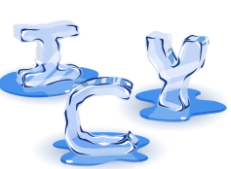If you’ve accidentally taken a sip of sea water or had to gargle with salt water, you’ve probably realized that freshwater and saltwater have some pretty important differences.
These differences exist not only when these waters are liquid, but also when they freeze. In this experiment, we will look at one major difference between frozen freshwater and frozen saltwater.
What You Need
- Table salt
- Water (tap water is fine)
- Transparent container, for example a clear water bottle with the top cut off or a drinking cup (x2)
- Food Dye (any color will work)
- Measuring cup
- Measuring spoon (teaspoon)
- Tape and marker for labeling
Before You Begin
As you read in the Frozen Life companion story, when sea ice forms, freshwater freezes and leaves behind a concentrated salt solution called brine. This brine is found in pockets throughout the ice. Brine pockets allow organisms that get trapped in the ice to avoid freezing and survive until the next spring. The pockets are small and isolated in winter, but in spring, as the ice begins to warm, the brine pockets get bigger and combine with other pockets to form channels which allow the organisms to move throughout the ice. You can explore the differences in channels between seasons in our channel maze.
In this experiment we are going to compare the difference between regular freshwater ice (the kind you would put in your drink) and sea ice. To do this we will create fresh and saltwater ice, then put a couple drops of dye on each type of ice and compare what happens. What do you think is going to happen? Do you think the dye will act the same in both ice types?
This should ideally be done over two days. The first four steps in the Procedure should be done on Day 1, and the remaining steps should be completed on Day 2.
Procedure (1-4 should be done ahead of time)
-
Measure out two cups of water into each of your two containers (you can use less if your container is too small). Make sure to leave a little room as the water will expand when it freezes.
- Using your tape and marker, label one container “water” and the other “salt water.”
- In your “salt water” container, dissolve 1.5 teaspoons of salt for every cup of water (so, if you have two cups, use 3 teaspoons).
- Put the containers in a freezer (this will take at few hours to freeze, best done overnight) and keep frozen until ready to perform experiment
- Take the ice out of the containers and set them next to each other. These are going to melt and make a mess so put the containers on a tray or a sink.
- Add 5 drops of dye to the top of the freshwater ice and note what happens. (If nothing seems to happen, you can add a few more drops of dye.)
- Add 5 drops of dye to the top of the saltwater ice and note what happens.
Using your observations, decide whether your predictions were correct (what happened and did the dye act the same in both ice types?). Make a conclusion about what you think is happening based off of what you saw. Then, when you’re done, you can move on to the next step.
Kyle Kinzler is a graduate student at Arizona State University and is working on his Masters thesis focusing on Arctic sea ice algae with Dr. Susanne Neuer. To learn more about Dr. Neuer’s research, visit What Lies Beneath.





